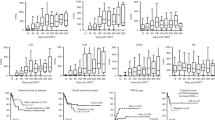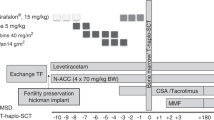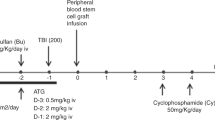Abstract
Here, the influence of T vs T and B cell depletion on the incidence of EBV-associated lymphoproliferative disorder (EBV-LPD) after bone marrow transplantation (BMT) from a matched unrelated donor (MUD) is analyzed. From 1982 to 1997 the soy bean agglutinin/sheep red blood cell (SBA/SRBC) method was used for T cell depletion. This technique is well established, but the use of SRBC has a risk of transmitting prions or viruses. Therefore, a new T cell depletion method was introduced, using CD2 and CD3 monoclonal antibodies (CD2/3 method) instead of SRBC. Unfortunately, this led to an unexpected high number of EBV-LPDs in patients receiving transplants from MUDs. SBA depletion was reintroduced and combined with the CD2/3 method (SBA/CD2/3) in this patient population, later replaced by B cell-specific (CD19 and CD22) antibodies (CD3/19/22 method). The number of T (× 105/kg) and B (× 105/kg) cells in the graft was 1.5 ± 0.8 and 2 ± 1 (T/B ratio 0.75), 2.2 ± 2.0 and 41 ± 21 (ratio 0.055), 5.0 ± 0.0 and 2 ± 1 (ratio 2.5), 2.5 ± 1.2 and 10 ± 6 (ratio 0.25) using the SBA/SRBC, CD2/3, SBA/CD2/3 and CD3/19/22 techniques, respectively. When B cell depletion was performed (SBA/SRBC, SBA/CD2/3, CD3/19/22) four out of 31 patients (13%) receiving a BMT from a MUD developed an EBV-LPD. Without B cell depletion (CD2/3) this occurred in five out of seven patients (71%) (P < 0.05). A T/B cell ratio in the graft of ⩾0.25 seems sufficient to significantly reduce the incidence of EBV-LPD after BMT from MUDs.
Bone Marrow Transplantation (2002) 29, 335–339. doi:10.1038/sj.bmt.1703362
This is a preview of subscription content, access via your institution
Access options
Subscribe to this journal
Receive 12 print issues and online access
$259.00 per year
only $21.58 per issue
Buy this article
- Purchase on Springer Link
- Instant access to full article PDF
Prices may be subject to local taxes which are calculated during checkout
Similar content being viewed by others
References
Kernan NA, Bartsch G, Ash RC et al. Analysis of 462 transplantations from unrelated donors facilitated by the national marrow donor program New Engl J Med 1993 328: 593 602
Arnold R, de Witte T, van Biezen A et al. Unrelated bone marrow transplantation in patients with myelodysplastic syndromes and secondary acute myeloid leukemia: an EBMT study Bone Marrow Transplant 1998 21: 1213 1216
Ferrara JLM, Deeg HJ . Graft-versus-host disease New Engl J Med 1991 324: 667 674
Curtis RE, Travis LB, Rowlings PA et al. Risk of lymphoproliferative disorders after bone marrow transplantation: a multi-institutional study Blood 1999 94: 2208 2216
Thomas ED, Storb R, Clift RA et al. Bone marrow transplantation New Engl J Med 1975 292: 832 843
Verdonck LF, Dekker AW, de Gast GC et al. Allogeneic bone marrow transplantation with a fixed low number of T cells in the marrow graft Blood 1994 83: 3090 3096
Verdonck LF, Dekker AW, Rozenberg-Arska M, van den Hoek MR . A risk adapted approach with a short course of ganciclovir to prevent cytomegalovirus (CMV) pneumonia in CMV-seropositive recipients of allogeneic bone marrow transplantation Clin Infect Dis 1997 24: 901 907
Reisner Y, Kirkpatrick D, Dupont B et al. Transplantation for acute leukaemia with HLA-A and B nonidentical parental marrow cells fractionated with soybean agglutinin and sheep red blood cells Lancet 1981 15: 327 331
Slaper-Cortenbach ICM, Wijngaarden-du Bois MJGJ, de Vries-van Rossen A et al. The depletion of T cells from haematopoietic stem cell transplants Rheumatology 1999 38: 751 754
Knowles DM, Cesarman E, Chadburn A et al. Correlative morphologic and molecular genetic analysis demonstrates three distinct categories of posttransplantation lymphoproliferative disorders Blood 1995 85: 552 565
Baurmann H, Revillard JP, Bonnefoy-Berard N, Schwerdtfeger R . Potent effects of ATG used as part of the conditioning in matched unrelated donor transplantation Blood 1998 92: S 290A (Abstr.)
Cohen JI . Epstein–Barr virus infection New Engl J Med 2000 343: 481 492
Gratama JW, Oosterveer MAP, Zwaan FE et al. Eradication of Epstein–Barr virus by allogeneic bone marrow transplantation: implications for sites of viral latency Proc Natl Acad Sci USA 1988 8: 8693 8696
Gratama JW, Oosterveer MAP, Lepoutre J et al. Serological and molecular studies of Epstein–Barr virus infection in allogeneic marrow graft recipients Transplantation 1990 49: 725 730
Cavazzana M, Bensoussan D, Jabado N et al. Prevention of EBV-induced Blymphoproliferative disorder by ex vivo marrow B cell depletion in HLA-phenoidentical or non-identical T depleted bone marrow transplantation Br J Haematol 1998 103: 543 551
Liu Z, Wilson JM, Jones MC et al. Addition of B cell depletion of donor marrow with anti-CD20 antibody to a T cell depletion regimen for prevention of EBV lymphoma after bone marrow transplantation Blood 1999 94: 638A (Abstr.)
Hale G, Waldmann H . Risks of developing Epstein–Barr virus-related lymphoproliferative disorders after T cell-depleted marrow transplants Blood 1998 91: 3079 3083
van Esser JWJ, van der Holt B, Meijer E et al. Epstein–Barr virus (EBV) reactivation is a frequent event after allogeneic stem cell transplantation (SCT) and quantitatively predicts EBV-lymphoproliferative disease following T cell depleted SCT Blood 2001 98: 972 978
Acknowledgements
We wish to thank Hans van Heugten, Jannie van der Giessen and Lex van der Gouw for performing T and T/B cell depletions of the grafts.
Author information
Authors and Affiliations
Rights and permissions
About this article
Cite this article
Meijer, E., Slaper-Cortenbach, I., Thijsen, S. et al. Increased incidence of EBV-associated lymphoproliferative disorders after allogeneic stem cell transplantation from matched unrelated donors due to a change of T cell depletion technique. Bone Marrow Transplant 29, 335–339 (2002). https://doi.org/10.1038/sj.bmt.1703362
Received:
Accepted:
Published:
Issue Date:
DOI: https://doi.org/10.1038/sj.bmt.1703362
Keywords
This article is cited by
-
The value of EBV DNA in early detection of post-transplant lymphoproliferative disorders among solid organ and hematopoietic stem cell transplant recipients
Journal of Cancer Research and Clinical Oncology (2018)
-
Successful rescue of early graft failure in pediatric patients using T-cell-depleted haploidentical hematopoietic SCT
Bone Marrow Transplantation (2014)
-
High incidence of post transplant lymphoproliferative disorder after antithymocyte globulin-based conditioning and ineffective prediction by day 28 EBV-specific T lymphocyte counts
Bone Marrow Transplantation (2011)
-
Current status of haploidentical stem cell transplantation for leukemia
Journal of Hematology & Oncology (2008)
-
Haploidentical haematopoietic stem cell transplantation for acute leukaemia in adults: experience in Europe and the United States
Bone Marrow Transplantation (2008)



